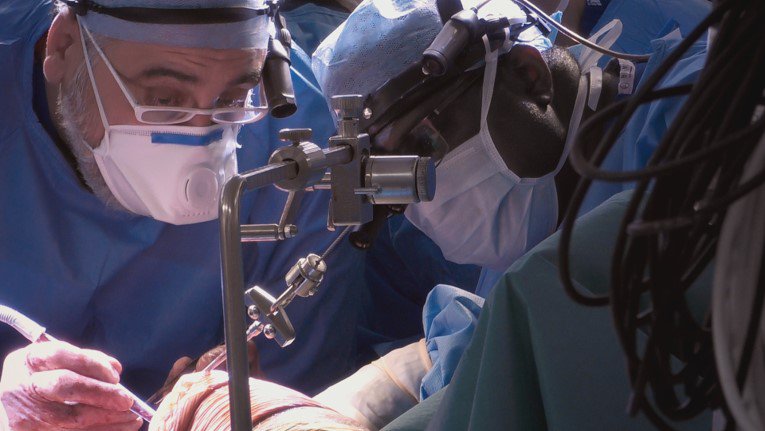Episode Two, 9pm, Tuesday, 13 October – Chest wall re-construction and acoustic neuroma
Non-urgent advice: Visit our Surgeons hub
Visit our Surgeons hub to go behind-the-scenes of the gripping third series of Surgeons: At the edge of life.
Catch-up on the series on BBC iPlayer.

One of the reasons consultant surgeon, Charles Malata, went into plastic surgery is he can instantly see how his speciality helps patients. He finds that “exciting and exhilarating”.
Viewers will relate to that when they watch the next episode of BBC Two’s ‘Surgeons: At the Edge of Life’ at 9pm on Tuesday (Oct 13) when Charles helps close a large hole in patient Kevin’s back.
Charles’ skill are called on by Royal Papworth’s senior consultant thoracic surgeon, Aman Coonar, who needs help with a marathon chest wall reconstruction that will take 18 hours.
Backed by a team of 25 colleagues, the pair aim to close a cavity that hasn’t healed since Kevin had a cancerous lung removed 17 years ago. The constant flow of fluid makes it impossible to lead a normal life, and It is hugely distressing for the former builder.
Kevin is in good hands. Charles qualified as a general surgeon at St James’ University Hospital in Leeds in 1990 and then as a plastic surgeon in 1997 at the world-famous Canniesburn Hospital in Glasgow.
Almost two years of super-specialty fellowships in breast and cosmetic surgery in the USA followed, before becoming a consultant at Addenbrooke’s in 1999. He was appointed research professor, and visiting professor of Anglia Ruskin University, in 2013.
Charles says the best part of his work is operating, especially when undertaking complex microvascular reconstructive surgery, similar to that carried out on Kevin, and when used for reconstructing breasts after mastectomy.
I also enjoy research, and have been involved in a number of innovative surgical techniques over the last 20 years.
Charles Malata
Also on Tuesday night, viewers will see Addenbrooke’s colleague, neurosurgeon Richard Mannion, put his skills to the test to remove a rare type of tumour, called an acoustic neuroma, from the brain of 47-year-old father of four Gulraiz.
The micro-dissection will take several hours, but Richard has been a surgeon for more than 20 years and won’t shrink from the task. As a medical student he was “hooked” on neuro-surgery the moment he witnessed a brain operation.
Before Richard can start ENT surgeon, Patrick Axon, has the daunting task of making a pathway to the tumour by drilling through Gulraiz’s skull without damaging the brain. It is a tense time.

Patrick has a special interest in otology (the study of anatomy and diseases of the ear), hearing implants, and skull base surgery. He has an international reputation for the management of middle and inner ear disease, as well as skull base pathology, accepting referrals from around the world. He is past president of the British Skull Base Society and Chairs the National Acoustic Neuroma Audit.
Patrick said: “Gulraiz was in a difficult position. He couldn’t continue without the surgery, but there were considerable risks associated with having it.
As surgeons it is humbling that he should put his trust in Richard and I, and it is our job to make it a success.
Patrick Axon
Richard added “As a trainee, it is the medical details that you find fascinating, but the older you get, the clearer it becomes that it is all about the patient. The variety in this work keeps it interesting every day, but the most rewarding part of the job is being a key part of people’s lives and helping them to overcome pain or disability.”
So with two of the toughest operations ahead, how did the surgeons feel about be asked to work in front of the cameras?
Richard said:
Most doctors do not seek out limelight, and rightly so in my opinion. However, I hope the episode is valuable for the general public and for patients who might be facing neurosurgery in the future. It seems frightening, but most do really well.”
Richard Mannion

